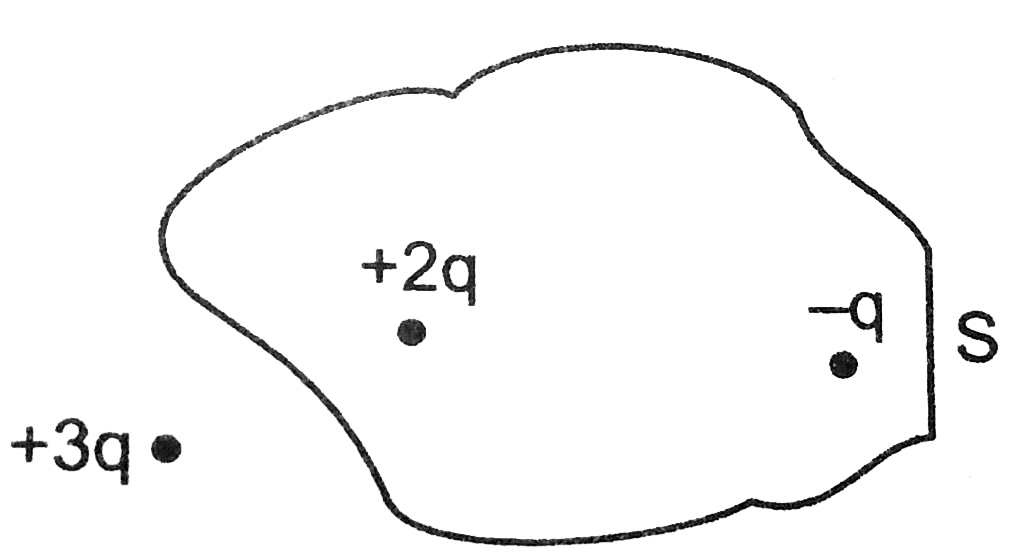∮→E.d→s= Electric flux through a closed surface 's'
Match the column :
Column IColumn II(A)The value of∮→E.d→s is affected by (p)+ve charge inside 's'(B)Electric field at a point inside 's' is affected by(q)−vecharge inside 's'(C)Electric field at a point outside 's' is affected by (r)+ve charge outside 's'(D)Electric field at a point at the surface of 's' is affected by (s)-ve charge outside 's'(t)Outside charges but very far away from 's'
The correct Answer is:A(p,q),B(p,q,r,s),C(p,q,r,s),D(p,q,r,s)
Topper's Solved these Questions
- ELECTRIC CHARGES AND FIELDS Book:AAKASH INSTITUTEChapter:ELECTRIC CHARGES AND FIELDS Exercise:SECTION-G(INTEGER ANSWER TYPE QUESTIONS)
Explore 1 Video
- ELECTRIC CHARGES AND FIELDS Book:AAKASH INSTITUTEChapter:ELECTRIC CHARGES AND FIELDS Exercise:SECTION-H( MULTIPLE TRUE-FALSE QUESTIONS)
Explore 10 Videos
- ELECTRIC CHARGES AND FIELDS Book:AAKASH INSTITUTEChapter:ELECTRIC CHARGES AND FIELDS Exercise:SECTION E(ASSERTION -REASON TYPE QUESTIONS)
Explore 10 Videos
- DUAL NATURE OF RADIATION AND MATTER Book:AAKASH INSTITUTEChapter:DUAL NATURE OF RADIATION AND MATTER Exercise:ASSIGNMENT (SECTION-D)
Explore 10 Videos
- ELECTROMAGNETIC INDUCTIONBook:AAKASH INSTITUTEChapter:ELECTROMAGNETIC INDUCTIONExercise:ASSIGNMENT(SECTION -D) Assertion-Reason type Question)
Explore 15 Videos
Similar Questions
If some charge is given to a conducting object of any shape, then match the following columns, under electrostatic condition
Column IColumn II(A)→E at a point within conducting material(p)Must be zero(B)→Eat a point outside the material (q)May be Zero(C)→Eat a point in a cavity having no charge(r)May be uniform but not zero(D)→Eat a point in the cavity having some charge(s)May be non-uniform(t)Cannot predict
View SolutionIf some charge is given to a conducting object of any shape, then match the following columns, under electrostatic condition
Column IColumn II(A)→E at a point within conducting material(p)Must be zero(B)→Eat a point outside the material (q)May be Zero(C)→Eat a point in a cavity having no charge(r)May be uniform but not zero(D)→Eat a point in the cavity having some charge(s)May be non-uniform(t)Cannot predict
View Solution
Knowledge Check
The flux of electric field due to these charges through the surface S is
 A2qε0B3qε0C−5qε0Dqε0
A2qε0B3qε0C−5qε0Dqε0The electric flux through a closed surface area S enclosing charge Q is ϕ If the surface area is doubled, then the flux is
A2ϕBϕ/2Cϕ/4DϕThe electric flux through a chlosed surface area S enclosing charge Q is ϕ. If the surface area is doubled, then the flux is
A2ϕBϕ/2Cϕ/4Dϕ
Column I shows distributionof electric field liness and column II shows charge distribution . Match the columns.
Column I Column II(A)Straight lines but not parallel(p)Uniformly distributed charged shell(B)Straight lines but parallel (q)Uniformly distributed charged long rod(C)Curved lines(r)Uniformly distributed infinite charged sheet(D)Some regions where no lines are present(s)Electric dipole(t)Any conducting material
View SolutionColumn I shows distributionof electric field liness and column II shows charge distribution . Match the columns.
Column I Column II(A)Straight lines but not parallel(p)Uniformly distributed charged shell(B)Straight lines but parallel (q)Uniformly distributed charged long rod(C)Curved lines(r)Uniformly distributed infinite charged sheet(D)Some regions where no lines are present(s)Electric dipole(t)Any conducting material
View SolutionColumn IColumn II(a)Electric Generator(p)Electric to Mechanical(b)Electric Motor(q)Electric to Heat(c)Burning(r)Mechanical to Electric(d)Hair dryer(s)Chemical to Heat
View SolutionFig shows three point charges +2q,−qand+3q, What is the electric flux due to this configuration through the surface S ?

View SolutionMatch the following :
Column I Column II(A) Steady electric field(p) Can accelerate a stationary charge(B) Steady magnetic field(q) Can accelerate a moving charge(C) Time varying magnetic field(r) Can change the speed of a charge(D) Induced electric field(s) Forms closed loops,
View Solution
